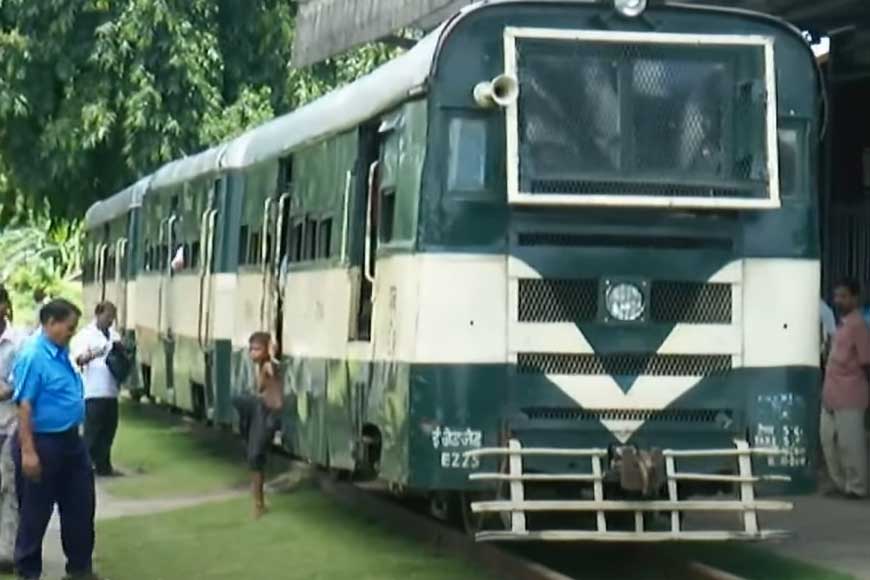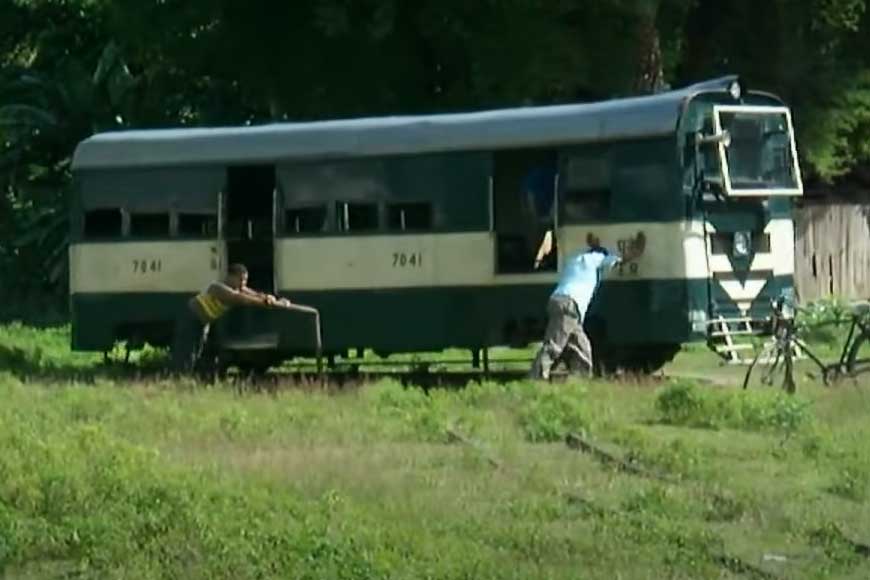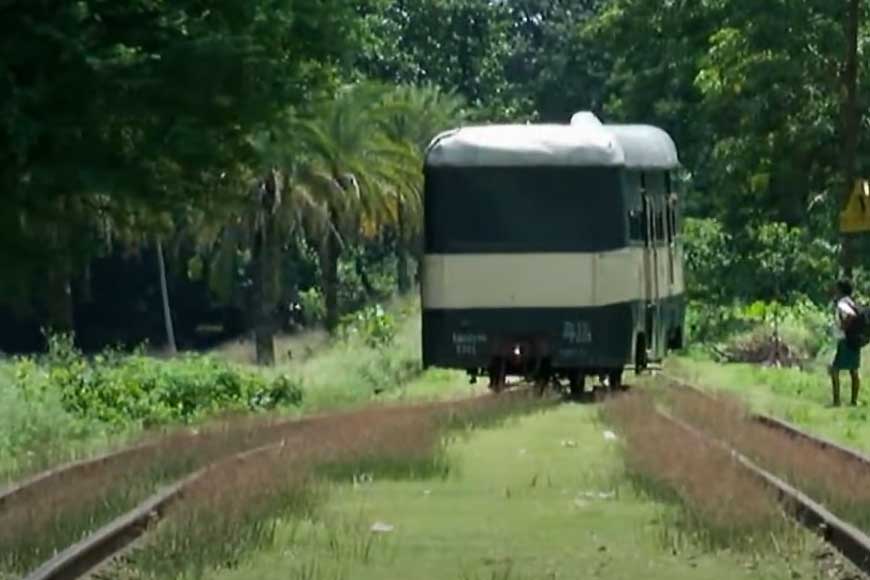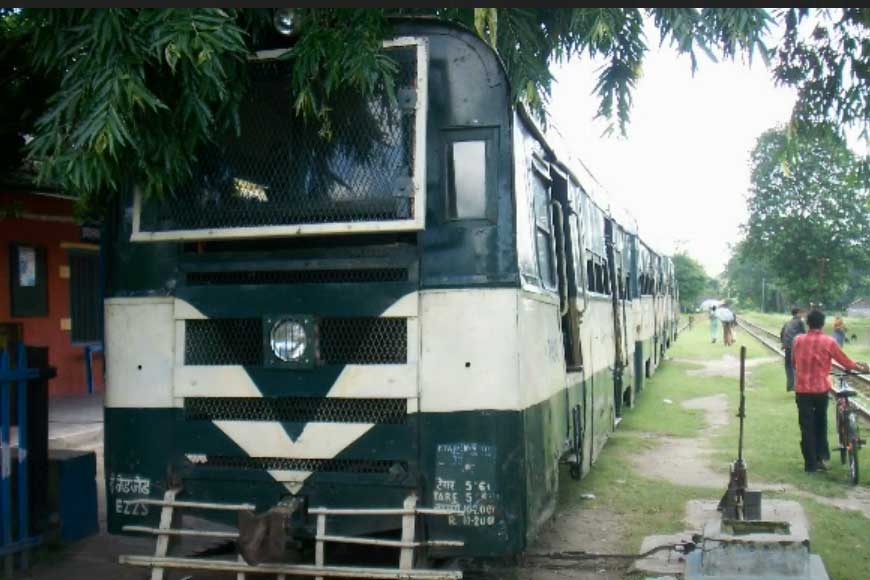The Santipur Local - Part 2

McLeod's Light Railways began operations on the Ahmedpur–Katwa Railway connecting Ahmadpur (now Birbhum district) and Katwa (now East Burdwan district) on 29 September 1917 in two phases. The railway was built in 2 ft 6 in (762 mm) gauge and the total length of the route was 52 kilometres (32 miles). The first phase began operations on May 30, 1917 when trains plied between Ahmedpur and Pachandi. In the second phase, the track was extended till Katowa from Pachondi. After Independence, the Union Government bought the route on July 1, 1967, and connected it with the Eastern Railways.
The Eastern Bengal Railway Company was incorporated by the Eastern Bengal Railway Act 1857 with the objective of introduction of railway transport in eastern Bengal and even to move into Burma. After the company was formed, the government signed a treaty with the Eastern Bengal Railway Company whereby the company was assigned to lay 111-mile long railway track to connect Calcutta with Kushtia. After five years of the treaty, finally on November 15, 1862, the work was completed and trains began operating between Sealdah and Kushtia. Although train service began on this route, two very prominent heritage centers of art, culture and learning of the 18th and 19th century Bengal – Krishnagar and Santipur – both in the same route, were bypassed. This hindered connection between Calcutta and Ranaghat.

Santipur-Nabadwip Light Railway was privately owned line constructed by MLR. In 1904, it was taken over by Eastern Bengal Railway (EBR) as part of its NG Network. The first batch of trains that plied from Aishtala Ghat were sub-standard. According to accounts recorded, the trains did not have a first class. The roofs of the compartments were covered with tin plates, benches were arranged inside for sitting and tattered canvas screens were put up to thwart the rains.
To resolve this issue, on April 5, 1899, East India Railway Company bifurcated and set up a branch route of the Sealdah- Kushtia route at Ranaghat. This 762 milimeter or two-and-a-half ft broad light train route branched out and moved for two miles, crossing the Churni River and then moving on to Aishtolaghat on its way to Krishnagar via Santipur. This news was reported in ‘The Statesman’ newspaper in its issue dated July 10, 1897. The move was praised highly: “We heartily welcome the Ranaghat-Krishnagar tramway plan. In order to accomplish the plan, a limited liability company has been registered recently. The company has a working capital of Rs 7 lakhs. The public is being encouraged to buy shares from the market for the project. The proposed steam tramway aka light railway will link Krishnagar, a major town of Nadia district with East Bengal Railway through Ranaghat via Santipur. Krishnagar has no link with the railways.
After railway route became operational in the Santipur-Krishnagar sector, it was extended till Nabadwip Ghat and opened to the public in 1898. Santipur-Nabadwip Light Railway was privately owned line constructed by MLR. In 1904, it was taken over by Eastern Bengal Railway (EBR) as part of its NG Network. The first batch of trains that plied from Aishtala Ghat were sub-standard. According to accounts recorded, the trains did not have a first class. The roofs of the compartments were covered with tin plates, benches were arranged inside for sitting and tattered canvas screens were put up to thwart the rains. After dusk, kerosene lamps were the only source of light inside the compartments as gas or electric lights were still not in vogue in trains. On May 31, 1925, construction of a bridge over the Churni River was finally over and the broad- gauge line was extended from Sealdah to Santipur via Ranaghat. This extension made the short distance light railway route between Ashtala Ghat and Santipur redundant but the narrow-gauge track from Santipur to Nabadwip Ghat via Krishnagar remained functional till 2010.
Trains ran on steam engines from Santipur’s Platform numbers 2 and 3 till the 1980s. These trains would generally have only three compartments but occasionally a fourth one would join. The more the merrier! The interiors of the compartments had the traditional rust red color similar to their exterior. Towards the second half of the 1980s, diesel engines replaced steam engines. After diesel trains were introduced, three pairs of trains plied on this route daily which would be increased during Raash Jatra, a major local annual festival. This train had eight compartments, including the engine. Compartment numbers 7031 and 7041 doubled up as engine room as well as a compartment that accommodated passengers. Here the engine driver would sit on the right and the diesel engine would be to his left, resembling the layout of local city buses. Barring this area, the rest of the compartment had long rows of seats for passengers.
There was no screen or barrier between the driver and passengers. There were 26 seats in the two compartments for passengers. Compartment numbers 7038, 7002 and 7009 were the compartments in between which were fully earmarked for passengers. Each of these three compartments had 42 seats. The rear end of the trains had compartments numbered 7040, 7042 and 7045 and these included the guard’s room. Here four seats would be removed from the total number of 42 seats to make a small room for the guard on duty. Each compartment would have two doors for entry and exit of passengers.
Also read : The Santipur Local
The total distance from Santipur to Nabadwip Ghat was barely 27.39 kilometers but the train moved at a snail’s pace and it took an hour and 40 minutes to cover the distance. In the initial phase, when the trains started running on diesel, the décor of the compartments were done aesthetically.
Before the train would take off, the compartment that had the engine, the rear compartment with the guard’s room and a compartment in the middle would be lined up. If any coach malfunctioned, it would be replaced by another one and the faulty one would be sent to the workshop for repair. The total distance from Santipur to Nabadwip Ghat was barely 27.39 kilometers but the train moved at a snail’s pace and it took an hour and 40 minutes to cover the distance. In the initial phase, when the trains started running on diesel, the décor of the compartments were done aesthetically. The roof and the lower portion of the compartments were done is orange and the middle portion would be doe in pristine white. Later the orange color was replaced by dark green. Actually, the décor of the compartments depended on the availability of colours at Kanchrapar Railway workshop. The three pairs of train that ran on the track were numbered 1/2NS, 3/4 NS and 5/6NS. Each way’s fare cost Rs 5 only. The signals were handled manually. The diesel engine operated on single direction control method so after the rain reached Santipur from Nabadwip, the direction of the engine would be reversed in a unique and complex manner. In the first stage, the compartment with the engine would be detached from the other two compartments. It would then be driven in reverse to a little distance away from the platform and attach it to a large turn-table like devise that resembled a potter’s wheel. The turn table would then be rotated with the help of two iron rods attached in opposite direction to 180 degrees so that the engine once again faced the direction of Nabadwip Ghat. Once this task was completed, the turn table locks would be unfastened and the engine would be driven back to the platform and attached to the two compartments for its journey back to Nabadwip.

In the beginning, the train would initiate its journey from Santipur and would halt at Dignagar (some say Gibindapur Kalibari), Krishnagar, Krishnagar Road, Amghata and Maheshgunj on its way to Nabadwip Ghat. This routine continued except that the train discontinued to stop at Krishnagar Road Station. Although the train was small, there was dearth of enthusiasm among passengers to board the vehicle. The train would leave Santipur Station advancing regally towards its destination. The crowded marketplace close to Gobindapur Kalibari would suddenly be alerted by the loud honking from the train that reverberated the atmosphere and could be heard from a great distance. People stopped on their tracks in wonder to get a glimpse of the majestic leviathan. Youngsters shouted in glee and even boarded the moving train for a short distance and then get off as smoothly from the train with great elan.
The train moved majestically parallel along National Highway Number 34, through vast undulating, never-ending stretches of green paddy fields. Passengers travelling on busses and other modes of surface transport would admire the train from a distance. Children would go into raptures as they sighted the train. The train was fast losing the race to time and speed but none could match its aristocracy, its class, its heritage, its past. It moved unruffled by the changes around. The train moved on its track for more than a century and was a silent witness to the many historical upheavals the country witnessed. People from distant lands rushed to undertake a memorable journey aboard this train and be a part of history itself.

Although this train was very popular and had been plying on this route for so long, the railway authorities had no emotional attachment for the vehicle. Despite millions of impediments, the train provided service diligently to passengers travelling between Santipur and Nabadwip Ghat for years. The train had endeared it to the railway employees as well. However, the century-old route came under the purview of the Union Railway ministry in 2009. The ministry realized the route was not feasible for narrow gauge route and decided to transform the route into broad gauge. On January 5, 2010, an official order was passed to this effect. The narrow gauge route was totally scrapped and it was finalized to lay broad gauge rail tracks. One January 17, 2010, Train number 5/6NS travelled on the route for one last time. It was time to bid adieu. Locals bade a teary-eyed farewell to their favourite train. At present, trains travel much faster on the broad-gauge line and connect Santipur to Amghata via Krishnagar but now only two pairs of train run daily between Santipur and Krishnagar.
Acknowledgment:
1. Kolikata Darpan, Radharaman Mitra, Subarnarekha, 1st Published, December 1952
2. Koler Shohor Kolkata, Siddhartha Ghosh, Readers’ Corner. 1st published, Raash Purnima, 1366 (Bengali calendar)










